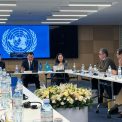The final meeting of the CHARIS Project (Contribution to High Asia Runoff from Ice and Snow) was held at the Ro-Chog Pel Hotel, Thimphu, Bhutan, for participants from Central and High Asia from June 5 to June 7, 2018. The program is supported by USAID. The coordinator of the research is the University of Boulder, Colorado, USA.
About 50 representatives of various universities and research organizations from the USA, Kazakhstan, Kyrgyzstan, Afghanistan, Pakistan, India, Nepal, and Bhutan took part in the seminar. Participants from the Institute of Geography of the Ministry of Education and Science of the Republic of Kazakhstan: A.B. Egorov, L.V. Kogutenko. Representatives of organizations interested in the results of the project took part in the work of the final meeting: the Scientific and Information Center for Interstate Coordination of the Water Commission of Central Asia (Tajikistan); National Institute for Strategic Studies (Kyrgyzstan); Water and Energy Commission, Government of Nepal (Nepal); Water and Energy Development Authority (Pakistan); Office of Economic Development and Agriculture of the US Embassy, USAID (Pakistan); The US Embassy in Islamabad, USAID (Pakistan); Secretary of Agriculture, Civil Secretariat of the Government Heber Pakhunkwa (Pakistan); Asian Bureau of USAID (USA); US Embassy in Kathmandu (Nepal); Clean Energy and Environment Office, USAID (India).
Reports were heard on the work carried out within the framework of the CHARIS project from the representatives of each country of the participant, as well as the final reports of the project coordinators (R. Armstrong, M.Jo Brodzik, A. Racoviteanu) on the first day of the meeting. Report on the main results of this project from the Institute of Geography was presented by Egorov A.B. (Figure 1). Discussions were held in groups on topics of interest: the mass balance of glaciers, sampling for hydrological analysis, remote sensing and mapping of glaciers, and the development of cooperation. After the group discussion, small presentations were made with generalized problems and ideas for their solution for further consideration for all participants (Figure 2). Discussions were held on the results of the project and the possibilities of their application by regions on the second day: Eastern Himalayas, Indus, Central Asia. The results of the discussions were also presented for further discussion at the general meeting. The meeting resulted in the heard success stories of water management in the region on various examples and discussed further plans for joint cooperation between the organizations present.
An excursion was made to the famous monastery "Taksang-lakhang" ("Tiger's Nest"), which was built on a rock in the dazhag of Paro near the town of Paro at an altitude of 3120 m above sea level on the last day (Fig. 4).
The goal of the CHARIS project is to study the role of glaciers and seasonal snow in the water resources of the high mountainous Asia. This research is critically necessary for the future prediction of the availability and vulnerability of water resources. Joint scientific work with the Asian partners will provide regional information necessary for planning irrigation, electricity generation and water consumption in the lower regions. A better understanding of the current hydrological regime will provide a realistic picture of future risks and water security in the region. Details of the project's results can be found at http://nsidc.org/charis/.
The CHARIS program allowed to study new research methods, applications to GIS programs and new calculation models, which we successfully apply in the work on the subjects of the laboratory. Close contact with the leaders and coordinators of the project, with research groups from different countries, gives a good impulse for the scientific development of the glaciology of Kazakhstan.










